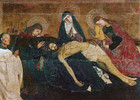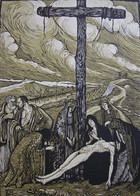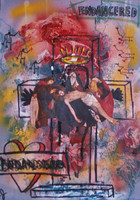Enguerrand Quarton
La Pieta de Villeneuve-les-Avignon (c. 1460)
Tempera on panel
When artists create images of the Pieta, they know they are taking on one of the most widely represented motifs in all of Christian art. Already by the end of the medieval period, the lamenting Mary, cradling the body of her son Jesus at the foot of the cross, had been depicted by so many artists in so many different variations it took a painter of rare talent (and inspiration) to come up with something so startling and new it would redefine established iconography of the scene. Fifteenth Century French Painter Enguerrand Quarton did precisely this in his magnificent Pieta de Villeneuve-les-Avignon.
The origins of the wood panel painting are unknown, as is the identity of the cleric in white surplice who commissioned the work, seen kneeling to the left of John, the Virgin Mary and Mary Magdelene. In fact, it has only been in recent years that the painting was even attributed to Quarton. Found in a remote chapel in Villeneuve-les Avignon in the Provence region where the artist worked most of his life, the Pieta created a sensation, when it was first exhibited at a 1904 Paris exhibition of French primitive art. It is now considered to be one of the greatest (if not the greatest) masterpieces of 15th Century French art.
Quarton's compositional master stroke is his modeling of the corpse of Christ, which bends above the dark blue robe of the Virgin Mary like a gleaming arc slashed across the panel. The curve of the legs is repeated in the outline of Mary Magdelene's cloak and echoed, yet again, in the fallen right arm and hand of Christ, shaped in a hook as the fingers curl in rigor mortis. The gold-embossed background is more suggestive of Byzantine iconography than Renaissance art, but our eyes are held captive by the expressive realism of this arced human form in the minimalist space.
Four pieces of art in my collection are direct descendants of the Quarton Pieta. Spanish-born Graphic Artist Louis Jou repeats the shape of Quarton's Christ in his 1913 woodcut, The Descent from the Cross, contrasting the curved white body with the Virgin's black robe in the frieze of mourners at the foot of an oppressively large Cross. The arced corpse appears again in the lithograph of the Deposition French Artist Paul Aizpiri created for a 1960 edition of the 15th Century text, La Passion de Nostre Seigneur. It bends like a bow across the page, enfolding Mary and three other grieving figures. The body of Christ is less curved in English Print-Make Gwen Raverat's Pieta, but the stark silhouette of the twisted upper torso and the fallen arm echo the Quarton painting. Outsider Artist E. J. has appropriated the entire Quarton image as the centerpiece and defining color palette for his "endangered" Crucifixion collage.





